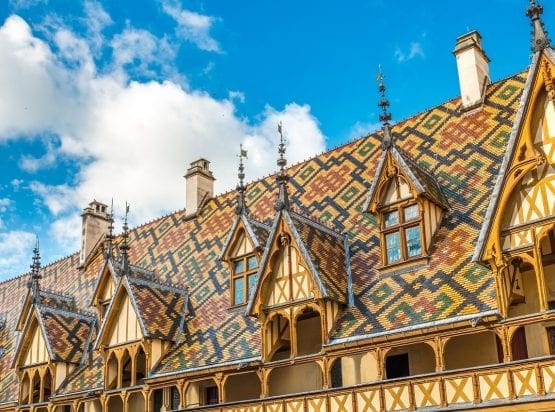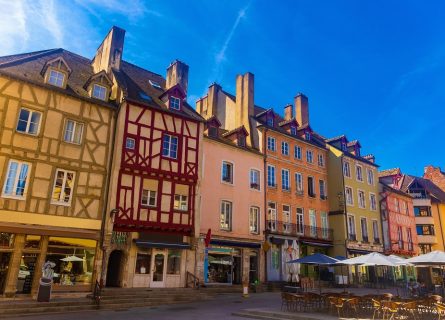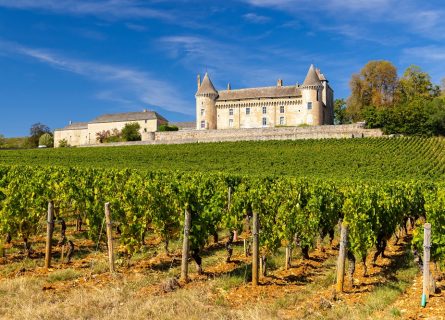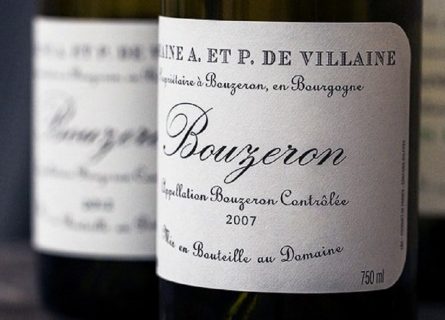Uncover Beaune's vibrant flavors and culinary gems with our expert guides. Plan an unforgettable trip now!
Read more
EXPLORE ALL OUR BURGUNDY WINE REGIONS GUIDE
Last updated: April 4, 2025
The Côte Chalonnaise is often pigeonholed as a decent value alternative to the Côte d’Or without the bells and whistles. The appellation is located just south of its more renowned neighbor; this extensive region cultivates the same grapes varieties, except Bouzeron Aligoté. It produces a broadly similar style of wine: structured Chardonnay whites and lively, red fruit-scented Pinot Noir.
Yet the Côte Chalonnaise has never commanded the same respect – or prices – as its illustrious neighbor, despite the vast improvements in quality seen over the past 25 years. But, if you give the region a chance, it will surely dazzle you.
Discover More About French Wine

Following their conquest of Gaul (France) in the last century BC, the Romans planted the sizable vineyards that now constitute the Côte Chalonnaise. It takes its name from the nearby city of Chalon-sur-Saône, the erstwhile capital of Burgundy in the 6th century. During the Roman era, Chalon-sur-Saône was an important river port and commercial center in the Western Empire. It transported large quantities of wine from the Côte Chalonnaise to towns and cities in northern France.
Archaeological Evidence of Roman Viticulture
Indeed, archaeologists have discovered more than 20,000 clay amphorae in Chalon-sur-Saône, preserved in the city graves and stamped with Roman emblems that are still visible today. However, after the Western Roman Empire collapsed in AD 476, viticulture died out as rival civilizations fought over the spoils of the Roman carcass.
Yet, as Chalon-sur-Saône reemerged as a center of Christianity in the 6th century, viticulture started to recover in the hills south of Chagny. Orders from Benedictine and Cistercian monks took over the cultivation and management of vines during the Middle Ages.
The Catholic Church exerted a powerful influence on Burgundy’s development, particularly in defining its most renowned terroirs and vineyards. After the completion of the Canal du Centre (a waterway linking the Saône and Loire Rivers) in 1792, the Côte Chalonnaise became a household name in the restaurants of northern Europe, considered the equal of the Mâconnais to the south and Chablis to the north.
Economic and Social Challenges in the Modern Era
Unfortunately, the area under vine declined significantly after the phylloxera epidemic of the late 1800s, while economic stagnation and rural depopulation took their toll in the mid-20th century.
The Côte Chalonnaise Today
Today, production in Côte Chalonnaise is relatively small, about a seventh of that of the Côte d’Or. Nevertheless, the vignoble has increased over the past two decades as investors migrate south, searching for affordable land in super-expensive Burgundy. Meanwhile, the region’s best wines now give Volnay, Meursault, and even Chambertin a run for their money—supple Pinot Noir and elegant Chardonnay.

The Côte Chalonnaise, also known as the Région de Mercurey, begins at the southern tip of the Côte d’Or. It runs south from the town of Chagny to the delightful Cluny. The Côte Chalonnaise boasts five key winemaking villages – Bouzeron, Rully, Mercurey, Givry, and Montagny – each honored with its own appellation.
Each of these communes produces a distinct interpretation of the Pinot Noir and/or Chardonnay grape, in addition to the surprisingly delicious whites of Aligoté in Bouzeron. The landscape, too, is quite reminiscent of the Côte de Beaune: rolling hills and sleepy villages invoke a quintessentially French rural scene.
Geographical and Climatic Features
Unlike the Côte d’Or with its continuous ridge, the Chalonnaise landscape features scattered limestone outcrops at various elevations. The Côte Chalonnaise breaks from the Côte d’Or’s singular focus on vineyards. Here, vines share the landscape with other crops and grazing land rather than dominating it entirely. Nevertheless, the Côte Chalonnaise has a similar continental climate with cold winters and warm, dry summers.
Soil Composition and Viticulture
Neither will you find significant differences in soil structure in these more southerly vineyards. Much like the Côte d’Or, calcareous terroir dominates here; a mixture of different limestones, gravel, and limestone mixed with clay suits both Pinot Noir and Chardonnay. Yet vineyards in the Côte Chalonnaise tend to ripen about 2-3 weeks later than their neighbors in the Côte d’Or—a cool vintage here can result in very tart and undernourished wines.
The Wind Factor and Ripening Challenges
The reason is wind: vineyards are less sheltered from the prevailing westerlies. Therefore, they require more sunny days to achieve good levels of phenolic ripeness. The most sheltered, gentle slopes with an eastern or southeastern aspect hold the finest climats (vineyard sites).
The soil composition strikes an ideal balance between drainage and moisture retention, enriched with a substantial content of minerals and calcium carbonate in the stratum, creating a fertile layer for vine growth. These exceptional terroirs can yield real depth and complexity in the best years, with generally accessible prices.
Bouzeron
Bouzeron’s fame chiefly comes from the pioneering work of Aubert de Villaine. He is the director of Domaine de la Romanée Conti in Vosne-Romanée. Domaine de Villaine matures Bouzeron, the only appellation exclusively dedicated to the Aligoté grape, in large wooden casks before releasing them. The result is a floral and fresh white that confounds expectations when tasted blind. According to the great man himself, the secret to his success lies in the limestone-rich marls of Bouzeron; the lack of surface soil is another factor, helping to keep yields low as it curtails plant growth during the wet spring seasons. Meanwhile, vines planted on south-facing slopes in Bouzeron produce good value Pinot and Chardonnay, marketed as Bourgogne-Côte Chalonnaise.
Rully
Rully has long built its reputation on producing excellent Chardonnay. It offers a facsimile of the village Chassagne-Montrachet without the price tag. In the best years, it is brisk, high in acid, and full of flavor; cooler vintages yield ideal base wines for the production of Cremant de Bourgogne. This fresh and fruity bubbly boosts the Rully economy. Over 4 million bottles are made yearly, and a growing percentage is exported worldwide. However, Pinot Noir also thrives on the calcareous marls of the zone, producing a very soft and accessible expression of this challenging grape. It compares favorably to the village wines of Beaune and Santenay.
Mercurey
This is the heartland of bright, floral, and well-made Pinot Noir in the Côte Chalonnaise. It is quite a large area with more acreage than Beaune or Gevrey-Chambertin in the Côte de Nuits. Winemakers actively seek out the appellation’s best sites for their Premier Cru wines. These sites typically boast south-facing slopes with limestone-rich soils. Mercurey also benefits from the continuing interest – and investment – of some influential merchant houses, not least Michel Juillot and Domaine Faiveley. The appellation also produces a small volume of white wine. However, it is rarely as exciting as the Pinot Noir.
Givry
Despite being half the size of its neighbor Mercurey, this modest commune boasts many reputable growers, with a significant number embracing organic viticulture. The local terroir contains more sand than Rully or Mercurey and small outcrops of red clay. The best wines, which include only a tiny amount of white, offer bright, stylish interpretations of the Pinot Noir grape, featuring fresh acidity and soft fruit. They are always approachable on release.
Montagny
If Mercurey is the capital of exceptional Pinot Noir in the Côte Chalonnaise, then Montagny is undoubtedly the greatest white wine village outside of the Côte de Beaune. The appellation boasts over 300 hectares planted with Chardonnay, including some highly regarded climats. You can find these prized vineyards below the village of Buxy and in the villages of Montagny, Jully-lès-Buxy, and Saint-Vallerin. The appellation’s blend of Jurassic-era limestone, clay, and quartz soils contributes to the Côte Chalonnaise’s formidable Chardonnay wines. These wines are distinguished by their exceptional longevity and intense flavor concentration.
Montagny appellation rules are strict: only white wines get the official designation.

There is little difference between the winemaking culture of the Côte Chalonnaise and its larger neighbor, the Côte de Beaune. Both regions have a strictly delineated hierarchy of vineyards, starting with the generic Bourgogne appellation, moving up to village wines, and finishing with the superior Premier Cru designation. Yet there are no Grand Cru terroirs in the Côte Chalonnaise, despite calls for promotion from several key producers.
Evolution of the Appellation
Before 1990, entry-level wines from this zone lacked a regional identity. They were labeled as Bourgogne Rouge (red) or Bourgogne Blanc (white). The late 20th century saw the introduction of a separate appellation, Bourgogne-Côte Chalonnaise, to designate these wines specifically. This appellation covers red and rosé wines from Pinot Noir and whites from Chardonnay and Aligoté.
The Rising Popularity of Cremant de Bourgogne
Meanwhile, the Cremant de Bourgogne designation is becoming more popular with each vintage as the global demand for affordable alternatives to Champagne reaches a fever pitch. The law dictates that every bottle of Cremant de Bourgogne undergoes a secondary fermentation in the bottle, following the traditional method. To diversify their offerings, growers in the Côte Chalonnaise are now crafting some of the region’s most esteemed cremant. Only the vignerons of Alsace come close in terms of consistency and quality.
Modern Winemaking Techniques
However, the critical mass of bottles produced in the region are still red and white wines. The best growers and merchant houses vinify their top labels with the same care and attention as the leading terroirs of the Côte d’Or. Stainless steel is used to maintain freshness and purity in the whites, while maturation in barrique adds texture, depth, and structure to the final product.
Example of Excellence
Domaine de Villaine exemplifies top-notch winemaking in the Côte Chalonnaise. It ferments hand-harvested berries in wooden foudres (large barrels) with 30-40 hectoliter capacities. The winemaker maintains the temperature below 71 degrees Fahrenheit. They press each parcel separately to maximize choice when assembling the final blend.
After a cold soak in stainless steel, the wine undergoes fermentation and aging in large oak casks, with bottling occurring after about 12 months of maturation. The resulting wines show immense purity and an unmistakable terroir character—a true flagship for the Côte Chalonnaise.
Discover more about Burgundy Wine Classifications
Critics have long dismissed the Côte Chalonnaise as a humdrum and unexciting addition to the Burgundian portfolio. Indeed, until recently, relatively few buyers and sommeliers bothered prospecting in the vineyards south of Chagny. Yet, three excellent reasons exist to give this dynamic region a closer look.
A Renaissance in Sparkling Wine
The first concerns the growing volume of very affordable and high-quality fizz being made in the Côte Chalonnaise. In the 20th century, a certain rusticity and lack of fruit cursed Cremant de Bourgogne. However, recent investments have transformed the potential of this very underrated bubbly. It is often marketed at under $20 and delivers a mouthful of citrus and stone fruit, supported by ripe acidity and a lively, vivacious mousse. After a sustained promotion campaign from the regional body, Burgundy sparklers are making a reputation for themselves. Incidentally, worth the hype!
Exceptional Value Across the Board
The second is the fantastic price-to-quality ratio that, with the exception of Domaine Leroy, characterizes almost every bottle of Pinot Noir and Chardonnay made on the limestone slopes of the Côte Chalonnaise. The local Chardonnay, enhanced by a touch of barrel fermentation, is ripe and structured. It echoes the richness of Meursault and the elegance of Chassagne-Montrachet.
Aligoté: The Hidden Gem of the Côte Chalonnaise
Meanwhile, the leading Pinot Noir vineyards of Mercurey are rapidly closing the gap between this region and the Côte de Beaune. But Givry and Rully also make juicy and delicious wines of real presence; biodynamic viticulture is the coming thing, spearheaded by Aubert de Villaine and increasingly adopted by hipster growers in the more fashionable parts of the Côte Chalonnaise. It all adds up to an explosion in quality that oenophiles will not want to miss!
Lastly, few destinations in the world can do proper justice to the grossly maligned Aligoté grape. But the Côte Chalonnaise is one of them. When matured in oak and harvested at very low yields, Aligoté can deliver a great deal of vinous pleasure: ripe flavors allied to high acidity. The best examples are very fine – an underrated source of charming, aromatic wines. They showcase all the intricate mineral flavors that consumers associate with the most famous villages and domaines of the Côte d’Or. But, in this case, the pleasure comes without the financial pain.
Discover Aligoté, the dazzling white wine grape from Burgundy, boasting zesty, citrus-infused charm. 🍇🍷 Experience French winemaking at its finest!
Find out moreChardonnay is a green-skinned grape varietal native to the Burgundy wine region in France and one of the most popular varieties worldwide.
Find out morePinot noir is a light-bodied red wine varietal closely related to the Vitis vinifera grape and produces the most sought-after red wines in the world.
Find out moreAlthough quaint villages and charming hamlets pepper the Côte Chalonnaise, your best bet for a slap-up meal is the old town of Chalon-sur-Saône. There, you will discover a plethora of bistros and excellent restaurants serving classical dishes in a relaxed and friendly atmosphere. Top choices include the seminal French cliché that is Coq au vin, roast perch marinated in butter, licorice root, and sage, and the iconic Escargots Bourguignon.
A Guide to the Gastronomy of Burgundy: Read more
If you would like us to customize an exclusive luxury tour, contact us and let us know your travel plans. We offer luxury food and wine tours for private groups of a mininium two guests. In addition, all of our private, chauffeured tours are available year-round upon request.

